

By Clement Miege
Hi there! After more than three weeks spent in the field, our team is very happy to be finally back, with many memories of the traverse. This year has been a very intense experience and I would like to tell you a little more about this expedition. I will focus on the days we were doing radar surveys. Indeed, two different studies were set up during this field work. The first one was during the traverse days, where we did a radar survey from one camp to another with a range of 50-90 kilometers (31-56 miles) between the camps. On the other days the surveys were smaller, set up around each camp; they consisted of a 10-km bowtie and a 280- by 280-meter (918- by 918-ft) grid to get a better idea of the spatial variability of snow layer depth surrounding each core site. These grid surveys will show us how representative the ice core is compared to the surrounding area and help answer the question of whether we would have gotten a different result if we had drilled our ice core a few paces this way or a few paces that way. We were also looking more in detail at the layering in a 2-meter (6.56-ft) snow pit; to do that, we were using a metal plate at different depths of the snow pit.
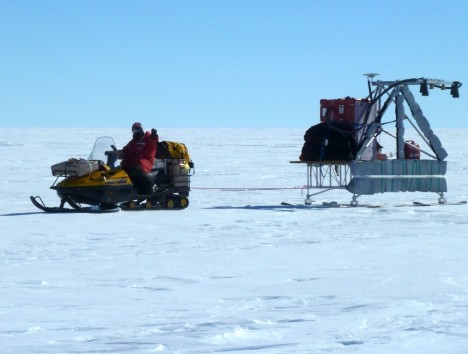
Here is a picture showing the two radars that operated simultaneously on the sled:
Both radars looked at the first 20 meters of the snow pack, sending electromagnetic waves into the snow. The snow radar (the big green horns in the picture) operates in a frequency range of 2-8 GHz. The other radar (the smaller brown horns) is the ku-band radar, sweeping between 12 to 18 GHz. The lower the frequency, the deeper the radars look. We have both radars for some redundancy in the system, imaging the snow/firn closest to the surface, which we core twice, and then the snow radar peers deeper than the cores to provide literally a deeper look. In addition to the 2 radars, we needed to know the elevation we were at, which is important for comparison with airborne data and also for modeling precipitation and temperatures. For that, we simultaneously collected GPS coordinates, which gave us our exact latitude, longitude and elevation every 5 seconds. The GPS antenna was on the very top of the sled, about 2.5 meters (8.2 feet) high.
On this sled, beside the radars sitting in the red box, we had packed: a blue bag, two black duffel bags and an orange bag. The blue bag was a survival bag, with all the gear needed in case we would have been caught in a storm; it included a tent, a stove, a shovel, and some food. The two black bags contained Ludo’s and my sleep kits, and the orange bag had some extra food, in case we were stuck for couple days. For the snow mobile, we had a repair kit under the seat to troubleshoot a possible failure. We were carrying two extra cans of gas as well. With this set-up, we were able to get a pretty light sled that was still comfortable and had all the gear we’d need in case of a storm or other circumstance separated us from the rest of the team, who were carrying all the camp gear. Fortunately, this never happened!
But now, let’s go back to the survey. The travelling days were the ones where the team was the most vulnerable: while we were traveling we had no shelters or camp set up to get back to if anything went wrong because we had to break down the entire camp in the morning, pack all gear on the sleds and ride with the snowmobiles pulling the sleds to the next camp. After driving between 50-90 km (31-56 mi), we would build our new camp, usually that same day in the afternoon. We had a total of seven travel days, covering a distance of about 500 km (310 mi).
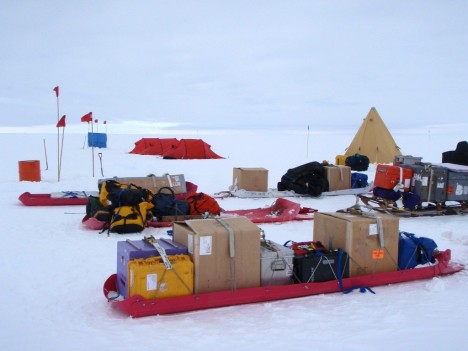
During travel days, the radar team left camp first, mostly because we had to drive at low speed to ensure the radar’s safety. Indeed, on the days we ran into large sastrugi (small ridges of hard snow), we drove at less than 10 km/h (6.2 mph). These sastrugi made our travel a little bit more difficult. Toward the end of the day, the team responsible for breaking down camp would leave the radar team and go 20 km (12 mi) ahead, to start setting up the new camp.
The days we were at camp, we did some small radar surveys: a bowtie and a grid around the core site. To help us drive the snowmobile straight for the grids, we set up flags to visualize the corners and sides. In the deep field, everything is white and flat, so it is hard to maintain a nice bearing just by following the GPS for such a small grid.
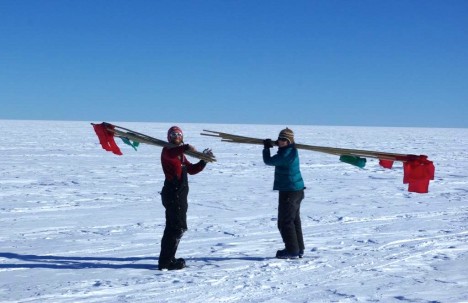
The last side survey with the radar was done in the snow pit. After analyzing the snow pit and picking up snow samples for further laboratory analysis, we used the pit to calibrate the radars and look at a detailed snow layering for the top 2 meters.

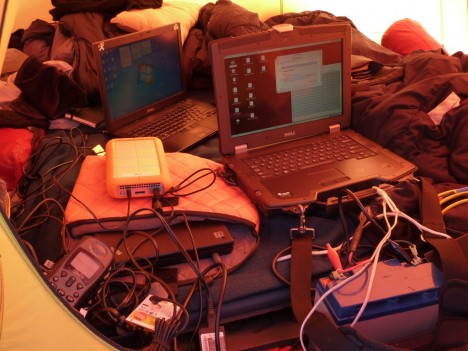

To conclude, I want to say that this traverse was definitely an amazing experience and I was happy to share such a good time with the team. I am already excited to start looking at the radar data in detail to see what we can learn of the past few decades of snow accumulation in this part of the West Antarctic Ice Sheet.
By Lora Koenig
Byrd Station (Antarctica), 11 December — We all got up at 5 AM this morning. I had gone to bed at 2 am because I had been backing up all of the radar data, which took much longer than anticipated. The traverse team went to bed early to be rested for the day.
It was a beautiful morning: warm, no wind, with thin, low, overcast clouds. The sleds were loaded and ready to go, already hooked on to the snowmobiles. Ludo was the first to the sleds and he started the generator, which powers heating pads that are used to warm the radars after being cold soaked all night. After about 15 minutes of warming, the radars can be started. During this time, the GPS is also turned on so it can obtain lock with the satellites and provide accurate positions.
I took the snowmobile covers off and helped Michelle load the final sleep kits on the sleds. The sleep kits are the last things to be loaded and contain a sleeping bag, sleeping bag liner, insolite pad, thermorest, pillow (if you want one, though most of us prefer to just use big red as a pillow), and a pee bottle so you don’t have to leave the tent in the middle of a cold night or storm. All of this is stuffed into a duffle bag and goes with you everywhere inAntarctica.
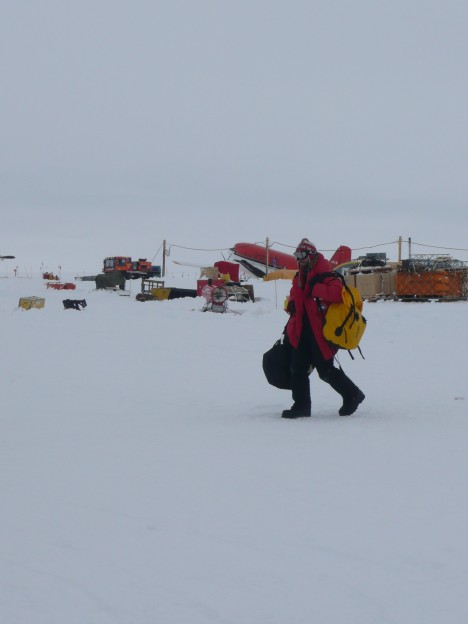
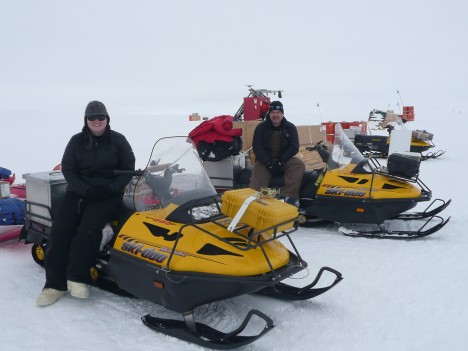
Once the generator was started, the team headed into the galley for a quick breakfast. Most of the camp was still asleep because Sunday is their day off; however, Kaija and Tony, the camp manager and assistant manager, came up to see the team off. After breakfast, the radars were turned on and the snowmobiles started. We took some final pictures and I tried to shoot some video but the small video camera we brought along is not operating well in the cold. The feeling of both excitement and nervousness was in the air. Excitement for finally getting to the traverse portion of the science and nervousness because the team is headed out into the remoteness ofAntarcticaalone. They will no longer have the security of an established camp and will have to rely on each other for everything. The team is strong and I know they will do well. During the traverse they will most certainly cover ground that no human has ever walked on before.
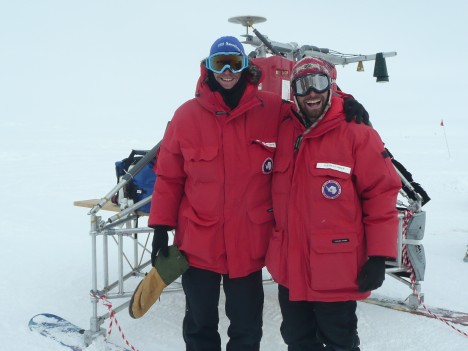
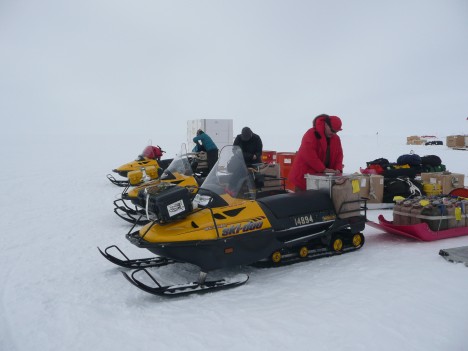
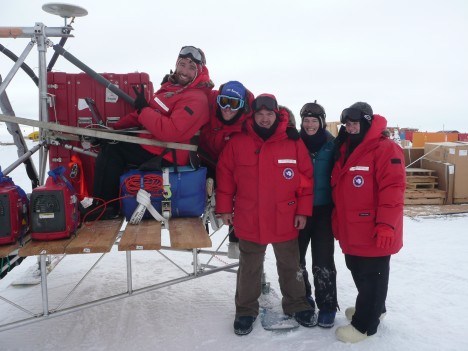
At 6:41 AM, Michelle led the team out of Byrd Camp. She pulled a Siglin sled and a Nansen sled with food, the Scott tent, an HF radio for emergency communication, the radar spare parts, the sleep kits and personal gear. Michelle rides one of the two snowmobiles with mirrors so she can easily watch the team. Jessica followed pulling 2 Siglin sleds with food, the ice core drill and two ice core boxes. Randy was third in line with two Siglin sleds with even more food, the mountain tents, emergency bag, and all of the fuel. Ludo pulled the final snowmobile out and into line pulling the radar sled with Clem on the sled operating the radar. We all screamed and waved as they pulled away.
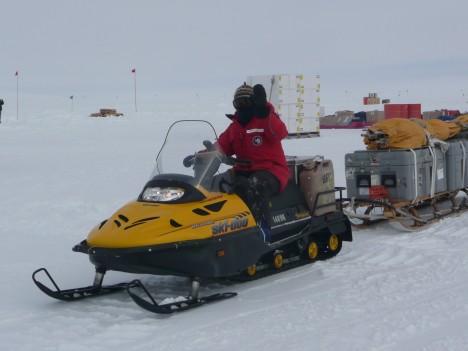
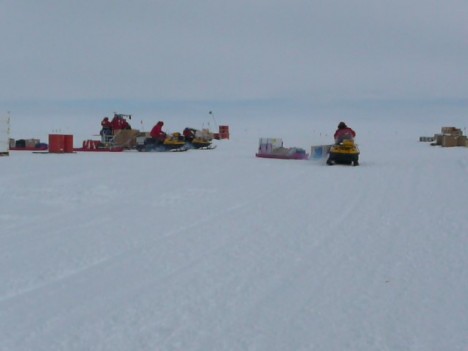

I continued to watch as they moved further towards the horizon. They became smaller and smaller dots on the horizon above tent city as they moved away from camp. At 7:12 AM their dots blurred into the horizon. The traverse had begun.

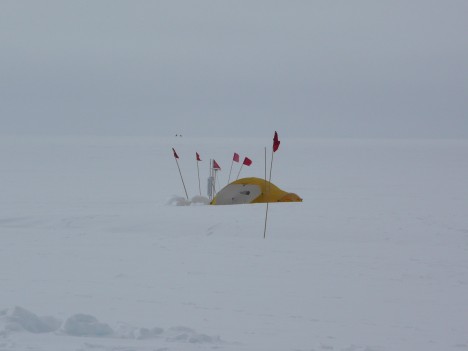
They will travel 95 km (59 mi) today, their longest stretch of the entire traverse, to the first camp site. They are moving toward higher snow accumulation and towards WAIS Divide field camp. When they reach the site tonight, they will be95 km(59 mi) from Byrd and85 km(52.8 mi) from WAIS Divide, so if they have any problems they will head to WAIS Divide, not Byrd.
I am feeling very lonely sitting in Byrd camp without the team, but there is still important work to do. Remember, the team still does not have their fuel caches. The pilots are in camp, but today’s overcast weather, while great for traversing, is not adequate for flying: The clouds make it difficult to see the snow surface. The pilots call this surface definition. In order to do open field landings (landings not on a ski way), the pilots cannot have overcast clouds at any level. Now I am just waiting for the weather to clear so that the plane can cache the team’s fuel and ice core boxes. I am also waiting for an LC-130 to come into Byrd so I can get a ride back to McMurdo and then back to the U.S.
Today I will also check the base station GPS and give a science lecture about our traverse to the Byrd Camp residents.
Everyone at Byrd Camp has helped us so we can complete our science goals and it is much appreciated. Thank you, Byrd Camp! We especially enjoyed the wonderful food made by Chef Rob. The team’s send-off dinner was duck with a port sauce, chicken with polenta, pureed carrots, broccoli with hollandaise sauce, and Boston Cream and Lemon Meringue pie for dessert. Yummmmm!
Around 7 PM tonight I expect to get a satellite phone call from Michelle. From this point on, the blog will have less pictures for a while because we will only have voice communication with the team. It should take between 24 and 30 days to complete the traverse, including (bad) weather days. The team will communicate back to me at each camp site and I will update you on their progress. When they return, we will post more posts from them with pictures of the traverse.
The team is truly out in the wilderness. The only communication they have is through the sat phone, which will only be on for a few hours in the evening. They can call their families and their families can send 160 character text messages to the sat phone. The deep field ofAntarcticais a remote place.
Go team, go!!!!!! (The extra exclamation points are for Clem, who loves to use them.)
Today, Clem and Ludo did a little science. They dragged the radar in a grid pattern around the ice core site from yesterday. This is important data because it tells us how representative the point where the ice core was drilled is of the larger area around it. When we compare ice core data to satellite data, we want to know if the larger area is homogeneous (similar) or not.
Randy made sure all the snowmobiles were ready and fueled to leave early in the morning. One of the choke leavers on a snowmobile broke off so he was working with the mechanic to get it fixed. Jessica looked at the electrical conductivity measurements from yesterday and took pictures of all of the log book pages to create a back up of the data. Michelle spent the day making sure all the gear was loaded well on the sled and that nothing was missing.
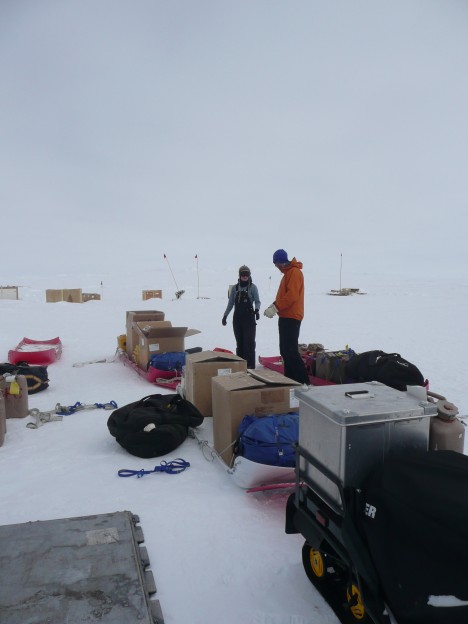
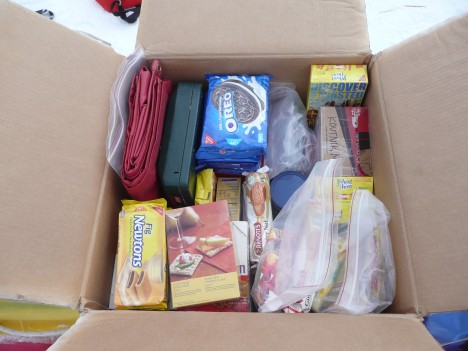
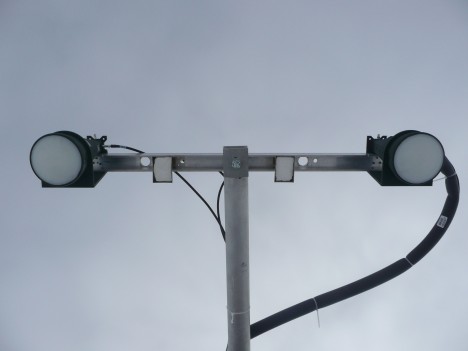
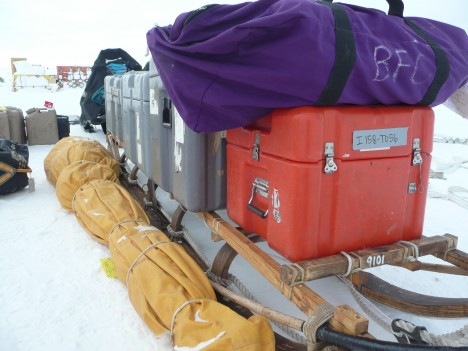
I spent most of the day watching the weather and talking with pilots. We cannot carry all of our gear on the sleds. A DC-3 Bassler aircraft is supposed to drop our fuel and ice core boxes and each camp site before the traverse. Due to the bad weather, the fuel cache has not yet been cached. So I have been talking with the pilots and rearranging the caches so the team can start out and not incur more delays. For now, the team will leave in the morning carrying two ice core boxes and one 55-gallon drum of fuel. This will allow them to get to the first camp site and drill. It will also give them enough fuel to get back to an established field camp if for some reason they don’t get any more fuel. They will not go to Camp 2 until they know the cache of fuel is there. Hopefully the cache will occur tomorrow or the next day so the traverse team will not be delayed.
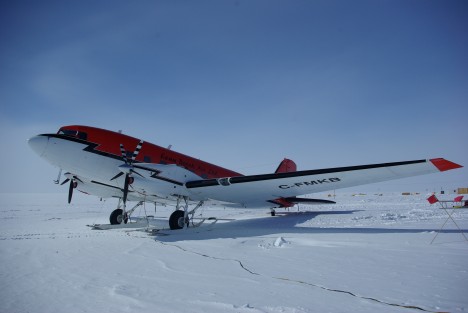
Everyone will go to sleep early tonight. Because all of Antarctica operates on McMurdo time, the time of the day at Byrd does not match the daily temperature changes. The coldest part of the day, which would generally fall from 1 to 4 AM, is usually between 6 and 10 PM our time. The warmest time falls in the morning between 6 and 10 AM. Tomorrow the team will get up at 5 AM and leave around 6 AM to take advantage of the warmest part of the day. By 6 PM they hope to be cooking dinner and in their warm tents.
By Lora Koenig
Byrd Station (Antarctica), 8 December — Today was our first day in the deep field at Byrd Camp. Byrd Camp sits in the middle of the West Antarctic Ice Sheet at an elevation of about 5,700 ft (1,737 m). We are standing on over 2,000 m of ice, with the oldest ice being about 50,000 years old. (The ice nearby at WAIS divide camp is a bit older and deeper. To find out more about the deep ice underneath us check out this information on the WAIS Divide ice core, which is being drilled deep into the ice nearby.) When you look out from camp you see nothing but the flat white snow and an old drill tower sticking out of the ground.
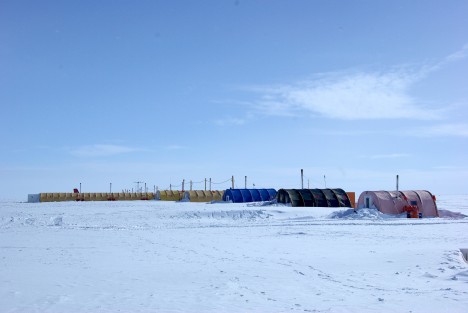
We are, specifically speaking, at Byrd Surface Camp. The original Byrd Camp, established in the 1956-1957 season, is underneath us, except for a drill tower that still sticks out above the snow. Over the years, snow accumulation (which averages around 12 cm per year at Byrd) buried the original camp and created Byrd Surface Camp, which everyone just calls Byrd. It is exactly this snow accumulation that we are here to measure with ice cores and radars. Here is an article about the history of Byrd.
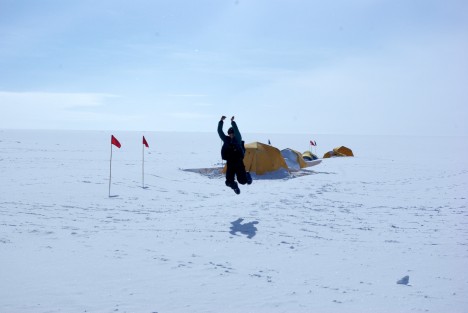
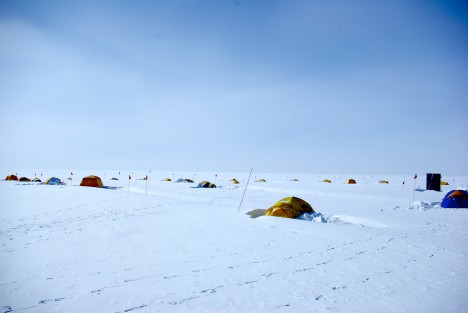
The team was prepared to work hard today because we know the more time we make up from the weather delays, the quicker the traverse team can get home. The day started with all of us breaking down the pallets of gear. Once all the gear was off of the pallets, we divided and conquered the tasks for the day. Michelle started loading and organizing the sleds. Randy fueled all the snowmobiles and Jerry cans. We brought nine 55-gallon drums of premix gas for the snowmobiles for the entire traverse. Jessica prepared all of the drilling gear for the first core, which we’ll drill tomorrow. Clem, Ludo and I built the radar sled, attached the antennas and hooked up all of the radars for testing. Clem also set up a GPS base station that we will use to correct our roving GPS on the radar so we know precisely where the radar data is located throughout the traverse.
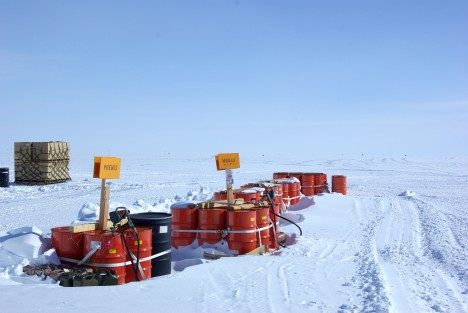
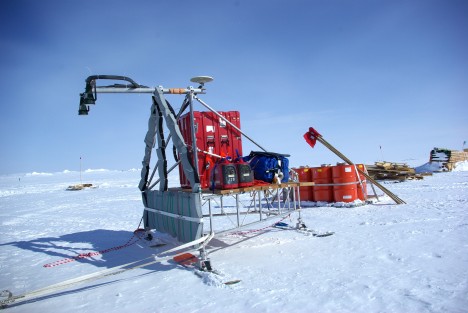
We discovered a few problems today. First, Jessica realized that the power converter for the drill battery did not make it to the field. The drill is made in Switzerland and has a different power plug. While this was an unfortunate oversight, it will not affect the science: We can charge the drill battery with the solar panels. The sun is up 24 hours a day here, so that will provide more than enough charge for the battery. Also, we carry an electronics tool kit, so in case of need we can cut the wires and make a new plug.— we call it “MacGyvering” (i.e., improvising fixes to our materials in the field).
The second problem of the day is a bit more worrisome. The Ku-band radar data has a systematic noise level that we cannot troubleshoot. We know that it has something to do with the computer that runs the radars, but we cannot determine whether or not the problem is coming from radio frequency emission from the computer itself getting into the antennas or if it is a data writing problem with the computer software. It has been a long day, so the trouble-shooting will have to be left for tomorrow. We hope that nothing was broken on the computer during the combat off-loading. We will know more tomorrow.
The sleds are ready to drill our first core tomorrow!
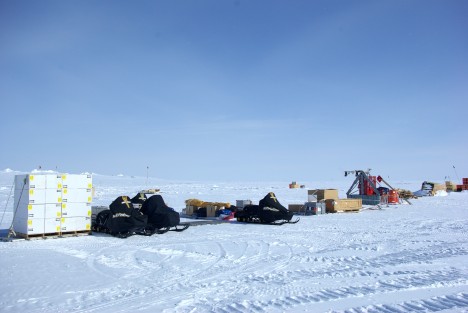
By Ludovic Brucker
Chers lecteurs francophones (que nous savons nombreux tels que familles, amis, et élèves de Goddard French Immersion Schéol), voici un petit récit résumant notre situation actuelle à Mc Murdo (77 o 51’ S, 166o 40’ E). Lors des prochains messages, nous essayerons d’avoir un court résumé du texte en français. N’hésitez pas à nous poser vos questions!
Tout d’abord, relatons l’objectif scientifique motivant cette campagne de terrain où nous ferons une traverse légère (déplacement en motoneiges et “nuitées” sous tentes) de 500 km durant le mois de décembre sur la partie ouest de la calotte Antarctique.
Nous cherchons à estimer l’accumulation de neige sur la calotte Antarctique, soit combien de centimètres de neige précipitent chaque année et s’accumulent avec le temps jusqu’à se métamorphoser en glace. L’Antarctique étant un immense continent d’une superficie d’environ 14 millions de km2 il est impossible d’obtenir cette information à partir de mesures locales obtenues depuis quelques stations. Par conséquent, notre objectif est d’utiliser des mesures satellites afin de retrouver cette information sur l’accumulation de neige à l’échelle continentale. Pour cela il nous faut tout d’abord obtenir des mesures in-situ pour développer des algorithmes servant à convertir la mesure satellite (celle d’un rayonnement électromagnétique, généralement dans le domaine des micro-ondes) en une grandeur physique (telle que accumulation de neige, température, densité, taille de grains de neige, ou encore présence d’eau liquide dans le manteau neigeux, etc.). Avec plus de 30 ans de mesures continuellement collectées par des radiomètres en orbite autour de la Terre, ces grandeurs servent au suivie climatique de la cryosphère en régions polaires.
Durant la traverse, cinq personnes seront présentes avec des rôles clés, définis:
– Michelle, au vue de son expérience lors de déploiements en régions polaires, est en charge du groupe. Après une prise en compte des idées/préoccupations de chacun, elle aura le dernier mot sur les choix stratégiques nous permettant d’évoluer en sécurité. Par exemple, il lui revient la décision de démonter le camp au petit matin afin de continuer la traverse, ou, au contraire, de rester une journée supplémentaire si le vent ou la visibilité ne permettent pas d’atteindre notre prochain point de ravitaillement en carburant (qui sera déposé dans quelques jours par avion). Michelle est également le contact radio avec le camp d’été à Byrd et la station McMurdo.
– Jessica et Randy s’occupent du forage de carottes de neige jusqu’à 15-20 mètres de profondeur, ainsi qu’aux premières analyses. Ils vont extraire des carottes d’environ 1 m de long et 5 cm de diamètre, puis les mesurer, peser et les mettre dans des tubes afin de les protéger. Ensuite, ces tubes seront transportés par avion jusqu’aux Etats-Unis.
– Clément travaille avec deux radars (bande C et Ku) que nous transportons sur un traineau spécial tracté par motoneige. Les jours de déplacement, Clément et Ludovic alterneront leur présence sur ce traineau et sur la motoneige. Comme vous vous en doutez, rester assis 8 à 10 heures à contrôler le bon enregistrement des mesures radars donne rapidement froid dans le dos ! Nous changerons donc de position très régulièrement. Durant les jours au camp, Clem passera l’essentiel de son temps aux révisions des instruments.
– Ludo, en plus de partager son temps avec Clem et les radars, réalisera des mesures des propriétés physiques de la neige dans des puits de 2 m de profondeur. En plus des mesures classiques de températures, densités, conductivité thermique, etc, nous prendrons également des photographies infrarouges permettant d’enregistrer la stratigraphie du manteau neigeux, et d’estimer la variation verticale de la taille des grains de neige.
Notre équipe présente cette année en Antarctique est composée pour le moment de 6 personnes, les 5 déjà présentés plus Lora! Lora est une experte de la NASA dont la thématique principale est l’analyse de mesures par télédétection active et passive des manteaux neigeux en Antarctique et au Groenland. Elle a déjà réalisé 7 déploiements sur calottes polaires, dont 3 en Antarctique, elle a aussi passé 4 mois consécutifs à Summit durant un hivernage au Groenland. Sa maîtrise des préparations d’expédition est un atout incroyable tout comme sa connaissance de la station McMurdo. Lora va venir avec nous jusqu’à Byrd afin de s’assurer que tout soit parfaitement en place, puis elle rentrera dans le Maryland pour célébrer la Noel avec sa famille.
Les présentations étant maintenant faites, résumons les différentes étapes excitantes de ces derniers jours! Nous avons quitté les Etats-Unis le 17 novembre en direction de Christchurch (Nouvelle-Zélande) avec un passage par Los Angeles (Californie) puis Auckland (Nouvelle-Zélande). Après avoir perdu une journée en passant la longitude de changement de date, l’arrivée en Nouvelle-Zélande s’est très bien déroulée pour toute l’équipe.
Dimanche 20 a été consacré à récupérer nos habits polaires (voir les photos associées aux autres textes en anglais). Nous avons notamment reçu “Big Red”, cette fameuse parka rouge de la National Science Fondation (NSF) et du programme antarctique américain (USAP).
Lundi 21 fut le jour du départ pour l’Antarctique. Après un vol de 5h, le C-17 de l’US Air Force a atterri sur la glace de mer au large de la station McMurdo. Un moment magique!
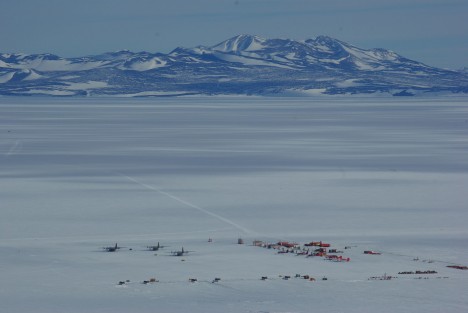
Nos premiers pas nous ont menés vers de particuliers engins, Delta et Terra bus, dédiés au transport en commun afin de relier la piste d’atterrissage à la Station de Mc Murdo.
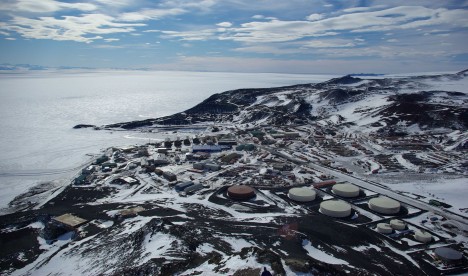
Les engins de transport à McMurdo sont soit équipés de chenilles, ou possèdent des roues d’une largeur exceptionnelle et d’une hauteur aussi grande que Clem!
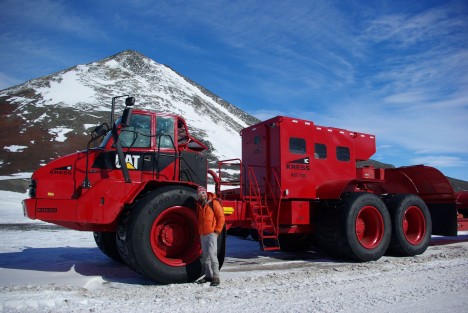
Mardi 22 et Mercredi 23, Jessica, Randy et Ludo ont suivi une formation de sécurité pour les déploiements en extérieur. Cette formation, bien mieux connue sous le nom de “Campeurs Joyeux!”, inclue une nuitée ensoleillée dehors, à proximité du Mont Erebus sur la plate-forme glaciaire de Ross. Pour varier les plaisirs, Jessica a passé la nuit dans une tente standard en forme de dôme, Randy dans une tente Scott en forme pyramidale afin de résister aux vents antarctiques. Sur recommandation de Clément, Ludo a quant à lui creusé une tranchée pour y passer une excellente nuit ensoleillée avec un panorama fantastique.

Durant ce temps, l’autre partie du groupe a commencé la chasse aux caisses d’équipement envoyées depuis le Kansas en septembre dernier. Malheureusement, nos radars n’ont pas été trouvés… Apres quelques heures de recherches ils ont été localisés sur un bateau à Christchurch.
Durant la journée du Jeudi 24, nous avons tous apporté notre grain de sel aux préparations. Il s’agissait de préparer les caisses de nourriture pour les prochaines semaines, soit 350 kg d’aliments.
La dernière journée de cette première semaine était dédié à finir les préparations de toutes les caisses en partance pour Byrd. Malheureusement les radars n’étaient toujours pas arrivés à McMurdo due aux conditions météorologiques empêchant les C-17 de voler. Plus précisément, les avions auraient pu atterrirent sans difficultés mais durant la phase de descente ils avaient à traverser une couche humide qui auraient généré de la glace sur la carlingue de l’avion une fois posé. L’aileron de queue étant très haut sur ces avions et l’usage des produits dégivrant limité, aucun avion en provenance de Christchurch s’est posé depuis notre arrivé.
Dans l’espoir de recevoir très prochainement les radars, nous allons poursuivre notre découverte de Mc Murdo et de la base néo-zélandaise Scott durant le week-end de Thanksgiving.
